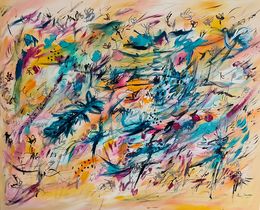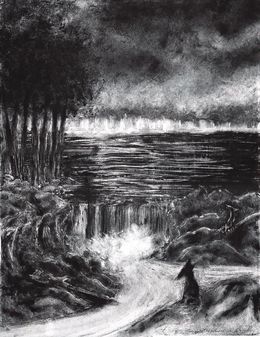
The Italian Artists of the Renaissance
Michelangelo, Donatello, Caravaggio, oh my! These immediately recognizable (and very Italian) names dominate the art world as we know it. Art historians, art lovers and tourists alike travel far and wide to see the artists’ masterpieces with their own eyes and to walk within the same walls that the grand masters once did. Let Artsper introduce you to the masters of the Italian Renaissance and what makes them so legendary!
Renaissance crash course
As the Middle Ages came to an end, European culture was reborn in the 14th century. Following an era where religion dominated all aspects of society, the Renaissance marked a shift towards a more humanistic outlook. Thus began a renewed interest in Greek and Roman antiquity with regards to science and technology, philosophy, literature, and most notably, the arts. In Italy in particular, the House of Medici, a most powerful family, supported these developments politically and monetarily. With Italy as the picturesque birthplace of the Renaissance, the masters of painting that we continue to study and admire today flourished.

The most iconic and immediately recognizable names of art history come from the Italian Renaissance, spanning from the 14th to 17th centuries. The grand masters of painting developed techniques that defined the period and that are still referred to today. Figures such as Michelangelo, Botticelli, Raphael, Donatello, and Caravaggio, just to name a few, became skilled at representing human figures and physical spaces in a more naturalistic manner than ever before.
Following paintings of the Middle Ages that lacked dimension and almost exclusively depicted the divine world, Renaissance painters shifted their focus to what was right in front of them. Thanks to the further study of human anatomy during the Renaissance and to the employment of the linear perspective, an architectural technique used by these artists to more realistically show proportions of physical spaces, Italian artists gained their spots in art history. Let’s get to know a few of the iconic, grand masters of the Italian Renaissance, who each had their own lasting influence on Western art.
Michelangelo, a larger-than-life career
Michelangelo di Lodovico Buonarroti Simoni, better known as Michelangelo, was a master of all mediums and the true definition of a dynamically talented Renaissance man. The multi-talented artist saw early success in response to his sculptures, paintings, and architectural projects. As a very young master, Michelangelo gained notability for two of his sculptures, titled Pietà and David. Although he did not consider himself a master painter, the artist took on one of the most ambitious fresco projects in history, painting the ceiling of the Sistine Chapel in Rome.

Michelangelo worked on this massive project over a period of four years in the early 16th century. Commissioned by Pope Julius II, the artist illustrated scenes of Genesis across the chapel’s ceiling. Michelangelo took free reign over the composition of the ceiling, separating different scenes into separate panels of the structure. The result is completely awe-inspiring to the chapel’s visitors and to Michelangelo’s contemporaries. His work had a strong influence on Mannerism, a subsequent art movement, and solidified the Renaissance man’s undeniable place as a grand master of Western art.
Donatello, sculpting a reborn Italy
Donato di Niccolò di Betto Bardi, known as Donatello, was an iconic Italian sculptor and painter of the late 14th to 15th centuries. It could be said that Donatello single-handedly revived the sculpting style from antiquity. His most famous sculpture, David, was the first freestanding male nude figure created since ancient Greek and Roman times. Donatello also sculpted many architectural reliefs for important buildings, monuments and churches throughout Italy. Alongside his variety of works, the artists’ sculpting style and techniques developed throughout his career. While his sculptures began as more monumental and classic, Donatello later moved towards a softer, sensual style, especially clear in David. In the final years of his career, the sculptor focused on more harsh and gruesome works. Despite these changes, Donatello’s sculptures are easily recognizable as his own because of his unfaltering talent.

Caravaggio, the master of light
Michelangelo Merisi da Caravaggio is perhaps known as the most dramatic Italian Renaissance painter. The artist became a master of representing emotional scenes with lively figures throughout the 16th century. Caravaggio’s humanistic and natural approach is exceptional in its expression. He frequently studied and painted in front of live models, strengthening his ability to observe and replicate the natural human form. Many of his scenes depicted rather harsh subjects such as violent combats and even death.

For example, the painting titled Judith Beheading Holofernes of the early 17th century depicts a biblical scene in which a widow decapitates a passed-out Assyrian general. The gruesome attack is exaggerated by Caravaggio’s employment of highlights and shadows. Harsh contrasts in light and dark became the artist’s signature technique, eventually being named “chiaroscuro.” Caravaggio stands out as a master Italian Renaissance painter, and his unique techniques even inspired forthcoming art movements.
The Renaissance in contemporary artwork
Renaissance artwork continues to inspire and influence contemporary art of today. The revival of classical ideas, techniques, and themes from the Renaissance era can be seen in the works of many contemporary artists. Whether it’s the meticulous attention to detail, the exploration of human emotions and anatomy, or the emphasis on perspective and composition, the Renaissance serves as a timeless source of inspiration. However, contemporary artists also bring their own unique perspectives, incorporating modern themes, technologies, and materials into their artworks. This fusion of past and present creates a rich tapestry of creativity that celebrates both tradition and innovation.


About Artsper
Founded in 2013, Artsper is an online marketplace for contemporary art. Partnering with 1,800 professional art galleries around the world, it makes discovering and acquiring art accessible to all.
Learn more













